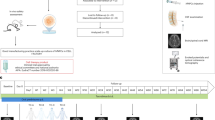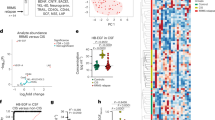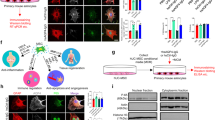Abstract
Mesenchymal stem cells (MSCs) have emerged as a potential therapy for a range of neural insults. In animal models of multiple sclerosis, an autoimmune disease that targets oligodendrocytes and myelin, treatment with human MSCs results in functional improvement that reflects both modulation of the immune response and myelin repair. Here we demonstrate that conditioned medium from human MSCs (MSC-CM) reduces functional deficits in mouse MOG35–55-induced experimental autoimmune encephalomyelitis (EAE) and promotes the development of oligodendrocytes and neurons. Functional assays identified hepatocyte growth factor (HGF) and its primary receptor cMet as critical in MSC-stimulated recovery in EAE, neural cell development and remyelination. Active MSC-CM contained HGF, and exogenously supplied HGF promoted recovery in EAE, whereas cMet and antibodies to HGF blocked the functional recovery mediated by HGF and MSC-CM. Systemic treatment with HGF markedly accelerated remyelination in lysolecithin-induced rat dorsal spinal cord lesions and in slice cultures. Together these data strongly implicate HGF in mediating MSC-stimulated functional recovery in animal models of multiple sclerosis.
This is a preview of subscription content, access via your institution
Access options
Subscribe to this journal
Receive 12 print issues and online access
$209.00 per year
only $17.42 per issue
Buy this article
- Purchase on Springer Link
- Instant access to full article PDF
Prices may be subject to local taxes which are calculated during checkout






Similar content being viewed by others
References
Prineas, J.W. The neuropathology of multiple sclerosis. in Handbook of Clinical Neurology (ed. Koestier, J.C.) 15–30 (Elsevier, Amsterdam, 1985).
Trapp, B.D. et al. Axonal transection in the lesions of multiple sclerosis. N. Engl. J. Med. 338, 278–285 (1998).
Wolswijk, G. & Noble, M. Identification of an adult-specific glial progenitor cell. Development 105, 387–400 (1989).
Reynolds, B.A. & Weiss, S. Generation of neurons and astrocytes from isolated cells of the adult mammalian central nervous system. Science 255, 1707–1710 (1992).
Ben-Hur, T. & Goldman, S.A. Prospects of cell therapy for disorders of myelin. Ann. NY Acad. Sci. 1142, 218–249 (2008).
Uccelli, A., Pistoia, V. & Moretta, L. Mesenchymal stem cells: a new strategy for immunosuppression? Trends Immunol. 28, 219–226 (2007).
Pluchino, S. et al. Injection of adult neurospheres induces recovery in a chronic model of multiple sclerosis. Nature 422, 688–694 (2003).
Busch, S.A. et al. Adult NG2+ cells are permissive to neurite outgrowth and stabilize sensory axons during macrophage-induced axonal dieback after spinal cord injury. J. Neurosci. 30, 255–265 (2010).
Caplan, A.I. & Dennis, J.E. Mesenchymal stem cell as trophic mediators. J. Cell Biochem. 98, 1076–1084 (2006).
Lazarus, H.M. et al. Cotransplantation of HLA-identical sibling culture-expanded mesenchymal stem cells and hematopoietic stem cells in hematologic malignancy patients. Biol. Blood Marrow Transplant. 11, 389–398 (2005).
Yoo, S.W. et al. Mesenchymal stem cells promote proliferation of endogenous neural stem cells and survival of newborn cells in a rat stroke model. Exp. Mol. Med. 40, 387–397 (2008).
Jung, D.I. et al. A comparison of autologous and allogenic bone marrow-derived mesenchymal stem cell transplantation in canine spinal cord injury. J. Neurol. Sci. 285, 67–77 (2009).
Bai, L. et al. Human bone marrow-derived mesenchymal stem cell induce Th2 polarized immune response and promote endogenous repair in animal models of multiple sclerosis. Glia 57, 1192–1203 (2009).
Rafei, M., Birman, E., Forner, K. & Galipeau, J. Allogeneic mesenchymal stem cells for treatment of experimental autoimmune encephalomyelitis. Mol. Ther. 17, 1799–1803 (2009).
Tanaka, F. et al. Exogenous administration of mesenchymal stem cells ameliorates dextran sulfate sodium-induced colitis via anti-inflammatory action in damaged tissue in rats. Life Sci. 83, 771–779 (2008).
Barhum, Y. et al. Intracerebroventricular transplantation of human mesenchymal stem cells induced to secrete neurotrophic factors attenuates clinical symptoms in a mouse model of multiple sclerosis. J. Mol. Neurosci. 41, 129–137 (2010).
Krampera, M. et al. Induction of neural-like differentiation in human mesenchymal stem cells derived from bone marrow, fat, spleen and thymus. Bone 40, 382–390 (2007).
Michalopoulos, G.K. Liver regeneration: molecular mechanisms of growth control. FASEB J. 4, 176–187 (1990).
Achim, C.L. et al. Expression of HGF and cMet in the developing and adult brain. Brain Res. Dev. Brain Res. 102, 299–303 (1997).
Sulpice, E. et al. Cross-talk between the VEGF-A and HGF signalling pathways in endothelial cells. Biol. Cell 101, 525–539 (2009).
Kitamura, K. et al. Hepatocyte growth factor promotes endogenous repair and functional recovery after spinal cord injury. J. Neurosci. Res. 85, 2332–2342 (2007).
Anan, F. et al. Predictors for silent cerebral infarction in patients with chronic renal failure undergoing hemodialysis. Metabolism 56, 593–598 (2007).
Deuse, T. et al. Hepatocyte growth factor or vascular endothelial growth factor gene transfer maximizes mesenchymal stem cell-based myocardial salvage after acute myocardial infarction. Circulation 120, S247–S254 (2009).
Sheth, P.R., Hays, J.L., Elferink, L.A. & Watowich, S.J. Biochemical basis for the functional switch that regulates hepatocyte growth factor receptor tyrosine kinase activation. Biochemistry 47, 4028–4038 (2008).
Sonnenberg, E., Meyer, D., Weidner, K.M. & Birchmeier, C. Scatter factor/hepatocyte growth factor and its receptor, the c-met tyrosine kinase, can mediate a signal exchange between mesenchyme and epithelia during mouse development. J. Cell Biol. 123, 223–235 (1993).
Ishiki, Y., Ohnishi, H., Muto, Y., Matsumoto, K. & Nakamura, T. Direct evidence that hepatocyte growth factor is a hepatotrophic factor for liver regeneration and has a potent antihepatitis effect in vivo. Hepatology 16, 1227–1235 (1992).
Polisetti, N. et al. Gene expression profile of epithelial cells and mesenchymal cells derived from limbal explant culture. Mol. Vis. 16, 1227–1240 (2010).
Wang, Y. et al. MEK, p38, and PI-3K mediate cross talk between EGFR and TNFR in enhancing hepatocyte growth factor production from human mesenchymal stem cells. Am. J. Physiol. Cell Physiol. 297, C1284–C1293 (2009).
Ebens, A. et al. Hepatocyte growth factor/scatter factor is an axonal chemoattractant and a neurotrophic factor for spinal motor neurons. Neuron 17, 1157–1172 (1996).
Yan, H. & Rivkees, S.A. Hepatocyte growth factor stimulates the proliferation and migration of oligodendrocyte precursor cells. J. Neurosci. Res. 69, 597–606 (2002).
Bottaro, D.P. et al. Identification of the hepatocyte growth factor receptor as the c-met proto-oncogene product. Science 251, 802–804 (1991).
Sun, W., Funakoshi, H. & Nakamura, T. Localization and functional role of hepatocyte growth factor (HGF) and its receptor c-met in the rat developing cerebral cortex. Brain Res. Mol. Brain Res. 103, 36–48 (2002).
van der Horst, E.H. et al. Discovery of fully human anti-MET monoclonal antibodies with antitumor activity against colon cancer tumor models in vivo. Neoplasia 11, 355–364 (2009).
Bai, L., Caplan, A., Lennon, D. & Miller, R.H. Mesenchymal stem cell signals regulate neural stem cell fate. Neurochem. Res. 32, 353–362 (2007).
Gerdoni, E. et al. Mesenchymal stem cells effectively modulate pathogenic immune response in experimental autoimmune encephalomyelitis. Ann. Neurol. 61, 219–227 (2007).
Siatskas, C., Payne, N.L., Short, M.A. & Bernard, C.C. A consensus statement addressing mesenchymal stem cell transplantation for multiple sclerosis: it′s time!. Stem Cell Rev. 4, 500–506 (2010).
Birchmeier, C. & Gherardi, E. Developmental roles of HGF/SF and its receptor, the c-Met tyrosine kinase. Trends Cell Biol. 8, 404–410 (1998).
Koç, O.N. et al. Allogeneic mesenchymal stem cell infusion for treatment of metachromatic leukodystrophy (MLD) and Hurler syndrome (MPS-IH). Bone Marrow Transplant. 30, 215–222 (2002).
Kuroiwa, T. et al. Hepatocyte growth factor ameliorates acute graft-versus-host disease and promotes hematopoietic function. J. Clin. Invest. 107, 1365–1373 (2001).
Futamatsu, H. et al. Hepatocyte growth factor ameliorates the progression of experimental autoimmune myocarditis: a potential role for induction of T helper 2 cytokines. Circ. Res. 96, 823–830 (2005).
Benkhoucha, M. et al. Hepatocyte growth factor inhibits CNS autoimmunity by inducing tolerogenic dendritic cells and CD25+Foxp3+ regulatory T cells. Proc. Natl. Acad. Sci. USA 107, 6424–6429 (2010).
Karussis, D. & Kassis, I. The potential use of stem cells in multiple sclerosis: an overview of the preclinical experience. Clin. Neurol. Neurosurg. 110, 889–896 (2008).
Di Renzo, M.F. et al. Selective expression of the Met/HGF receptor in human central nervous system microglia. Oncogene 8, 219–222 (1993).
Ghasemlou, N., Jeong, S.Y., Lacroix, S. & David, S. T cells contribute to lysophosphatidylcholine-induced macrophage activation and demyelination in the CNS. Glia 55, 294–302 (2007).
Franklin, R.J. & Ffrench-Constant, C. Remyelination in the CNS: from biology to therapy. Nat. Rev. Neurosci. 9, 839–855 (2008).
Pan, W. et al. Permeation of hepatocyte growth factor across the blood-brain barrier. Exp. Neurol. 201, 99–104 (2006).
Miller, R.H. & Fyffe-Maricich, S.L. Restoring the balance between disease and repair in multiple sclerosis: insights from mouse models. Dis. Model. Mech. 3, 535–539 (2010).
Hayashi, S. et al. Autocrine-paracrine effects of overexpression of hepatocyte growth factor gene on growth of endothelial cells. Biochem. Biophys. Res. Commun. 220, 539–545 (1996).
Kerstetter, A.E., Padovani-Claudio, D.A., Bai, L. & Miller, R.H. Inhibition of CXCR2 signaling promotes recovery in models of multiple sclerosis. Exp. Neurol. 220, 44–56 (2009).
Lennon, D.P. & Caplan, A.I. Isolation of human marrow-derived mesenchymal stem cells. Exp. Hematol. 34, 1604–1605 (2006).
Acknowledgements
We thank M. Hitomi for electron microscopy support, D. Carrino for help with fractionation, S. Miller for microfluidics and A. Kerstetter for help with cell culture. This study was supported by the Myelin Repair Foundation and US National Institutes of Health grant NS 30800 (R.H.M.) and the Virginia and David Baldwin Fund (A.I.C., D.P.L.).
Author information
Authors and Affiliations
Contributions
L.B., A.I.C. and R.H.M. conceived the study and experimental design. D.P.L. and A.I.C. prepared and processed the mesenchymal stem cells. L.B. performed all EAE experiments, immunohistochemistry and data analysis. A.Z. designed and conducted the slice and culture studies. J.H. and J.K. conducted the LPC lesion studies. L.B., A.I.C., A.D. and R.H.M. wrote the paper and designed the figures. All authors discussed the results and implications and commented on the manuscript at all stages.
Corresponding author
Ethics declarations
Competing interests
The authors declare no competing financial interests.
Supplementary information
Supplementary Text and Figures
Supplementary Figures 1–3 (PDF 1536 kb)
Rights and permissions
About this article
Cite this article
Bai, L., Lennon, D., Caplan, A. et al. Hepatocyte growth factor mediates mesenchymal stem cell–induced recovery in multiple sclerosis models. Nat Neurosci 15, 862–870 (2012). https://doi.org/10.1038/nn.3109
Received:
Accepted:
Published:
Issue Date:
DOI: https://doi.org/10.1038/nn.3109
This article is cited by
-
Mesenchymal stromal cell-derived secretome-based therapy for neurodegenerative diseases: overview of clinical trials
Stem Cell Research & Therapy (2023)
-
First trimester human umbilical cord perivascular cells (HUCPVC) modulate the kynurenine pathway and glutamate neurotransmission in an LPS-induced mouse model of neuroinflammation
Journal of Inflammation (2023)
-
Umbilical cord-derived mesenchymal stem cell sheets transplanted subcutaneously enhance cell retention and survival more than dissociated stem cell injections
Stem Cell Research & Therapy (2023)
-
Biology and therapeutic potential of mesenchymal stem cell extracellular vesicles in axial spondyloarthritis
Communications Biology (2023)
-
Hepatocyte growth factor-mediated apoptosis mechanisms of cytotoxic CD8+ T cells in normal and cirrhotic livers
Cell Death Discovery (2023)



